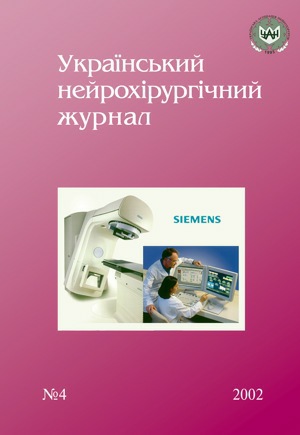Prognostic outcome of severe craniocerebral injury in different severity of the brain morphological impairments
Abstract
We used the severity of the morphological craniocerebral injury and the biochemical criterion for prognostic mathematical model development of severe craniocerebral injury (SCI) outcome. The received prognostic model is not highly reliable for the 3d and 5th post-traumatic day. It means that it is impossible to develop the highly reliable prognosis of SCI outcome on the basis of the combination of morphological craniocerebral injury severity and the biochemical criterion.References
1. Григорьев С.Г., Киреев О.В., Кувакин В.И. Многомерные методы статистического анализа категорированных данных медицинских исследований. — СПб, 1998. — 258 с.
2. Енюков И.С. Факторный, дискриминантный и кластерный анализ / Пер. с англ. — М., 1989. — 185 с.
3. Клименко Н.Б. Прогноз исходов черепно-мозговой травмы // Нейрохирургия. — 2001. — №2. — С. 19—23.
4. Кувакин В.И. Математико-статистические методы в клинической практике. — СПб., 1993. — 280 с.
5. Лихтерман Л.Б., Потапов А.А., Корниенко В.Н. Черепно-мозговая травма: прогноз течения и исходов. — М.: Книга ЛТД, 1993. — 299 с.
6. Педаченко Е.Г., Верхоглядова Т.П., Морозов А.Н. Клинико-морфологическая характеристика тяжелой черепно-мозговой травмы. //Укр. нейрохірург. журн. — 1998. — №7. — С. 18—24.
7. Черний В.И., Городник В.А., Чепега Е.Л. Прогнозирование исхода ЧМТ / Экстремальная медицина // Материалы III межобл. конф. — Луганск, 1999. — С. 141.
8. Шахнович А.Р., Мамадалиев А.М., Абакумова Л.Я. Прогнозирование исходов коматозных состояний в первые сутки после травмы // Вопр. нейрохирургии .— 1991. — №6. — С.11—12.
Downloads
How to Cite
Issue
Section
License
Copyright (c) 2002 L. A. Dzyak, O. A. Zozulya

This work is licensed under a Creative Commons Attribution 4.0 International License.
Ukrainian Neurosurgical Journal abides by the CREATIVE COMMONS copyright rights and permissions for open access journals.
Authors, who are published in this Journal, agree to the following conditions:
1. The authors reserve the right to authorship of the work and pass the first publication right of this work to the Journal under the terms of Creative Commons Attribution License, which allows others to freely distribute the published research with the obligatory reference to the authors of the original work and the first publication of the work in this Journal.
2. The authors have the right to conclude separate supplement agreements that relate to non-exclusive work distribution in the form of which it has been published by the Journal (for example, to upload the work to the online storage of the Journal or publish it as part of a monograph), provided that the reference to the first publication of the work in this Journal is included.









